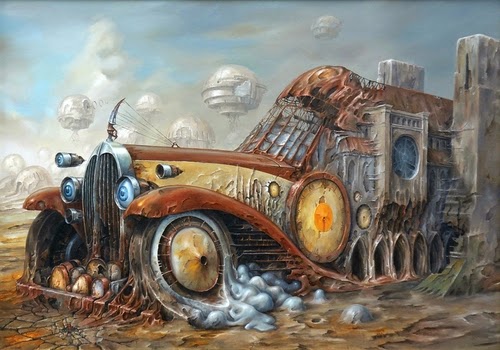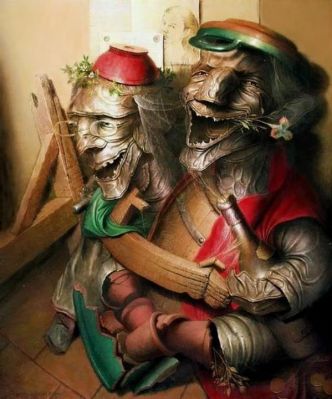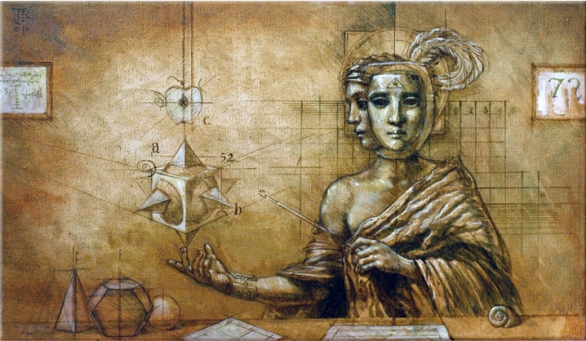
Continued from Part Three…
- 1900 Sigmund Freud publishes The Interpretation of Dreams, issuing a
caution to all lovers of hallucinatory fantasy. F. Anstey’s The Brass Bottle
toys with the idea of letting an intrusive fantasy get out of hand. L. Frank
Baum’s The Wonderful Wizard of Oz suggests that if you live in Kansas,
the grass might be greener on the other side of the portal. - 1902 Kipling’s Just So Stories inject a healthy dose of nonsense into the
business of fabulation. E. Nesbit’s Five Children and It adapts Ansteyan
fantasy for young readers. Arthur Machen’s Hieroglyphics explores the ecstatic dimension of enchantment. - 1904 J. M. Barrie’s Peter Pan explores the psychological politics of escapism. W. H. Hudson’s Green Mansions and H. G. Wells’s “The Country of the Blind” bid farewell to lost races.
- 1905 Lord Dunsany’s The Gods of Pegana goes in for secondary creation
on a large scale in lapidary form. The launch of Winsor McCay’s comic
strip Little Nemo in Slumberland adapts fantasy to a new and exceedingly
hospitable medium. - 1907 George Sterling’s “A Wine of Wizardry” sets out a manifesto for
fantasy in a suitably decadent style and demonstrates that the readers of
Cosmopolitan are small-town folk at heart. - 1908 G. K. Chesterton’s The Man Who Was Thursday demonstrates that the
spy story is an unsuitable medium for religious allegory. Kenneth Grahame’s
The Wind in the Willows demonstrates that animal fantasy is the last viable
refuge of Arcadian fantasy. Dunsany’s “The Sword of Welleran” attempts to
recast chivalric romance in the mold of heroic fantasy. William Hope Hodgson’s The House on the Borderland demonstrates the utility of leaky portals. - 1909 Maurice Maeterlinck’s The Blue Bird demonstrates that fantasy is
stageable, provided that one takes a sufficiently impressionistic approach. - 1910 Walter de la Mare’s The Return and Algernon Blackwood’s The
Human Chord fuse occult and existentialist fantasy. - 1912 James Stephens’s The Crock of Gold revisits the Irish Arcadia and finds it slightly tarnished. Edgar Rice Burroughs’s Tarzan of the Apes provides a key model of the Noble Savage.
- 1914 Anatole France’s The Revolt of the Angels provides literary satanism with its masterpiece, shortly before the outbreak of the Great War in August; shortly thereafter, Arthur Machen’s “The Bowmen” illustrates the hazards of fantastic indulgence in a time of great social stress. The Vorticist periodical Blast is founded, taking esoteric allegory to new extremes.
- 1915 Gustav Meyrink’s The Golem and Franz Kafka’s Metamorphosis
illustrate the anxieties bred by war. Jack London’s The Star Rover celebrates escapism. Machen’s The Great Return suggests that Wales was never in greater need of a grail. - 1917 James Branch Cabell’s The Cream of the Jest employs portal fantasy to mock the follies of American mores.
- 1918 A. Merritt’s “The Moon Pool” employs a definitive portal fantasy to issue a manifesto for escapist fantasy in pulp fiction. The Great War ends in November.
- 1919 Stella Benson’s Living Alone indicates the need for postwar reenchantment. James Branch Cabell’s Jurgen continues his symbolist satirization of American mores and is fortunate enough to excite stern opposition.
- 1920 David Lindsay’s A Voyage to Arcturus modernizes metaphysical allegory. The Capek brothers’ Insect Play and Hugh Lofting’s The Story of
Dr. Doolittle provide contrasting templates for modern animal fantasy.
Jessie Weston’s scholarly fantasy From Ritual to Record makes an important contribution to the ideology of Celtic Arthurian fantasy. - 1921 Barry Pain’s Going Home takes sentimental fantasy to a new extreme.
- 1922 Eric Rucker Eddison’s The Worm Ouroboros demonstrates several
new extremes to which transfiguration of epic materials might go. David
Garnett’s Lady into Fox modernizes theriomorphic fantasy. Ben Hecht’s
Fantazius Mallare celebrates the perversities of delusionary fantasy. - 1923 Weird Tales begins publication.
- 1924 Dunsany’s The King of Elfland’s Daughter gives Faerie a crucial
symbolic role in the politics of re-enchantment. - 1925 Margaret Irwin’s These Mortals and Christopher Morley’s Thunder
on the Left reverse the conventional direction of portal fantasy in order to
highlight the moral effects of disenchantment. - 1926 Ronald Fraser’s Flower Phantoms considers the metaphysical implications of erotic fantasy. Hope Mirrlees’s Lud-in-the-Mist revisits the symbolism of forbidden fruit. Thorne Smith’s Topper adapts Ansteyan fantasy to an American milieu. Sylvia Townsend Warner’s Lolly Willowes casts the Devil as a loving huntsman.
- 1927 John Erskine’s Adam and Eve adapts Edenic fantasy to the purposes of modern satire. Herman Hesse’s Steppenwolf suggests that the magical Theatre of the Imagination might hold the answer to problems of alienation. T. F. Powys’s Mr. Weston’s Good Wine offers a revised account of divine benevolence.
- 1928 Wyndham Lewis’s The Childermass transfigures Dantean fantasy
for the modernist era. Robert Nathan’s The Bishop’s Wife imagines that
even angels can fall in love. George Sylvester Viereck and Paul Eldridge’s My First Two Thousand Years explores the ways in which an accursed wanderer might profitably employ an extended sojourn in the world. Lewis Spence’s The Mysteries of Britain collates the scholarly fantasies underlying modern Celtic fantasy. - 1929 Aleister Crowley’s Moonchild provides a key example of occult fantasy informed by scholarly and lifestyle fantasies. Robert E. Howard’s “The Shadow Kingdom” offers a tentative template for sword and sorcery fiction.
- 1930 Charles Williams’s War in Heaven demonstrates that genre thrillers
might benefit from a dash of religious fantasy. - 1931 T. F. Powys’s “The Only Penitent” suggests that the moral rearmament of the confessional might work both ways.
- 1932 Robert E. Howard’s first Conan story establishes a more authoritative exemplar for sword-and-sorcery fiction. John Cowper Powys’s A Glastonbury Romance explores the potential of reckless mythological syncresis.
- 1933 C. L. Moore’s “Shambleau” hybridizes planetary romance and mythical fantasy. James Hilton’s Lost Horizon establishes a new escapist myth.
- 1934 C. L. Moore’s “Black God’s Kiss” feminizes sword and sorcery
fiction in graphic fashion. - 1935 Charles G. Finney’s The Circus of Dr Lao employs a circus as a
mirror to various hidden aspects of the American Dream. Herbert Read’s
The Green Child remodels the underworld of Faerie in surreal fashion. - 1936 Evangeline Walton’s The Virgin and the Swine demonstrates the
utility of Celtic fantasy in the dramatization of post-Frazerian scholarly
fantasy. - 1937 J. R. R. Tolkien’s The Hobbit; or, There and Back Again sets a crucial precedent for modern immersive fantasy. Stephen Vincent Benét’s “The Devil and Daniel Webster” sets up a crucial title fight between the Devil and an American lawyer.
- 1938 T. H. White’s The Sword in the Stone provides significant new models of education and wizardry. Mikhail Bulgakov writes The Master and Margarita, knowing that he will be unable to publish its satanic rebellion against Stalinism. J. R. R. Tolkien’s lecture “On Fairy Tales” offers an unprecedentedly robust apologia for fantasy literature.
- 1939 Unknown provides a vital arena for the development of chimerical fantasy. Flann O’Brien’s At Swim-Two-Birds takes metafiction to new extremes. James Thurber’s “The Secret Life of Walter Mitty” provides a classic description of everyday escapism. World War II begins in September.
- 1940 Jorge Luis Borges, Adolfo Bioy Casares, and Silvina Ocampo compile a showcase anthology of international fantasy literature. Robert Nathan’s Portrait of Jennie provides a key example of sentimental fantasy.
- 1941 The United States becomes embroiled in World War II in December.
- 1942 C. S. Lewis’s The Screwtape Letters breaks new tactical ground in
propagandistic Christian fantasy. - 1943 Antoine de Saint-Exupéry’s The Little Prince provides a parable of
enchantment destined to become the best-selling book of the 20th century. - 1944 Neil M. Gunn’s The Green Isle of the Great Deep wonders whether
heaven itself might be endangered by the spirit of Fascism. - 1945 C. S. Lewis’s The Great Divorce redraws the map of Dantean fantasy in a calculatedly unmelodramatic style. George Orwell’s Animal Farm adapts animal fantasy to modern political allegory. Charles Williams’s All Hallows’ Eve places the war-torn world in a melodramatic metaphysical context. In August, World War II is concluded with an unprecedented melodramatic flourish.
- 1946 Mervyn Peake’s Titus Groan sets a new standard in Gothic grotesquerie. Mervyn Wall’s The Unfortunate Fursey lends a new sophistication to humorous fantasy.
- 1948 Fletcher Pratt’s The Well of the Unicorn begins the sophistication
of American heroic fantasy. - 1949 Joseph Campbell’s The Hero with a Thousand Faces maps the essential features of the heroic quest. The Magazine of Fantasy is launched
(becoming The Magazine of Fantasy Science Fiction after its second issue).
-Stableford, Brian. The A to Z of Fantasy Literature. (Scarecrow Press, 1989)



